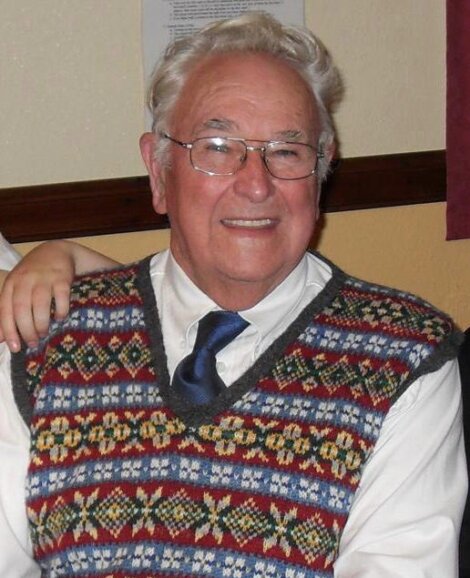Tributes / Memories of a very special man
Mary Blance pays tribute to writer, poet and former Brae teacher George PS Peterson who has died aged 90.
When the poet Vagaland died, George PS Peterson wrote: “No only me, bit Shetland mourns for him as weel”. I think it’s as true of George as it was of Vagaland.
George enriched many lives – as well as his significant personal relationships – husband, father, grandfather, great-grandfather, he was a much-loved teacher and colleague. Outside the classroom, he influenced many folk through his wide ranging interests.
He delighted in nature and the world about him, as well as being a crofter, writer, poet, storyteller, folklorist, genealogist, historian, scholar, linguist, researcher, archivist, diarist and fiddler, while his deep faith was just part of his being.
Most of all, his name will be associated with Papa Stour – as if the P.S. in his name was destined to stand for the isle that meant so much to him. He moved there when he was two and as a boy he loved to hear its music and stories, saying in later life that: “I cam ta feel it you were grippin da soul o da isle wi da stories and da fiddle music.”
He bought his first fiddle at 14 and was able to join in the music making at island gatherings, especially enjoying playing for the dancing.
He once told Rhoda Bulter that at the island school he discovered that books were “pure magic”. That reading experience was likely the root of his sheer pleasure in writing. “It’s great fun playin wi wirds” he said once “laek tryin oot colour”. He could paint too.
Part of his poetic legacy to Shetland is Dee and Me, the lyrical love poem he wrote for his wife Frances when they got engaged. It’s now almost a standard at Shetland wedding services, both at home and away.
Become a member of Shetland News
His first book of poetry Hairst Blinks Ower Papa came out in 1965, the year he married Frances Doull from Muckle Roe. They’d started courting after he started teaching in Brae. They went on to enjoy family life, with four bairns and later the blessing of grand bairns and great grand bairns .
Brae might have become home but he was a regular visitor to Papa Stour whatever the season – and where the family kept up the croft he’d had to leave to continue his education.
As an undergraduate he studied Swedish, Anglo-Saxon and Old Icelandic, and he had a real passion for his own island speech. He said: “I write in as rich a Papa dialect as I can muster.” You can truly hear George’s voice and the sound of Papa if you read a poem like Da Stirleen out loud.
It was in the 1960s that he became aware that the Papa Stour Sword Dance was again under threat – it had been revived earlier in the 20th century but was at risk again. He’d first danced it when he was 16 in 1949 and now he came to the rescue with the help of Brae School head teacher Norman Sutherland and technical teacher Bertie Mowat. Secondary school boys gathered to learn the dance. The tradition is safe now in the hands of George’s family. Another legacy.
George’s storytelling is ‘aert-kent’ and many have come ‘fae aa da airts’ to hear him. Whether they were traditional tales, sea stories, legends, even trowie stories he’d written himself, he could always charm an audience and consciously used storytelling as a teaching tool.
I recall being in Brae High School doing a piece of dialect research. The 6th year pupils we met informed us that one way to encourage the survival of da midder tongue in school would be to send pupils on a guided walk, using dialect, with George. On an outing like that, they said, you’d enjoy yourself as well as learning. The young folk appreciated his gift.
His book Auld Papa, I’m Dine gives us a real insight into the man. It’s a mixture of fact and fiction, prose and poetry, stories for bairns and more. My favourite section is the series of extracts from his diary. When he was peerie, George’s grandfather kept a log and it fascinated the little boy to watch the old man writing his reports.
This inspired George to start his own diary when he left home to go to school in Lerwick at 14. He recorded details from home and further afield. Here’s an extract to give you a flavour of what it’s like – on 30 March 1953, he notes that “Mary and I carried six fraachts of waar by kishie from the Outer Geos to finish off the midden roog.” A note in 1954 records that “wool this year was seven shillings a pound”.
What makes the diary an extra-special family heirloom are the drawings and paintings that illustrate its pages. I still mind how thrilled I was when he handed the diary to me to browse through.
George has left us so much. There’s the hand-written archive from his historical research and the books and articles he published but most of all we have the memories of a very special man. We mind his lightsome company, his warmth and kindness, his compassion, his rich laugh, his love for his family, friends and community,
Tanks, George, for bein wi wis. Fareweel.
George PS Peterson, born 7 October 1932, died 10 November 2022.




































































